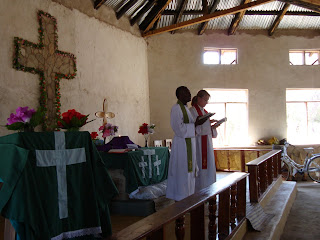Village #4: Makambalala

The Youth Choir processes into the sanctuary, singing and dancing and kicking up the dust from the hard packed dirt floor. Hanging from the rafters are strings tied with colorful strips of fabric to decorate the space. Dappled light shines through the windows, a lacey checkerboard pattern in the brick wall created by omitting alternate bricks. The singing is loud and joyful, the energy is high. We're at Makambalala. To accompany the singing, there might be two drums, made with skins stretched across a hollow log. This girl slaps a homemade shaker. It's a stick, two long nails, and pop bottle caps that spin on the nails. The sound is something like a cross between a tambourine, maracas and jingle bells. Every visit includes a time for prayer, and prayer is memorable at Makambalala. In recent years, this congregation has adopted the practice of a fervent, spirit led community prayer. The pastor or worship leader will introduce the prayer, and then the congregation members start m




